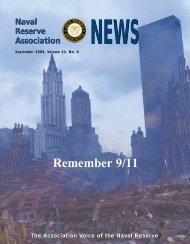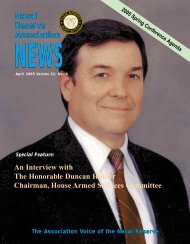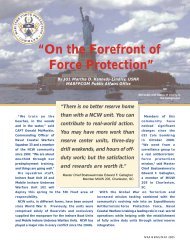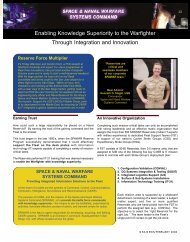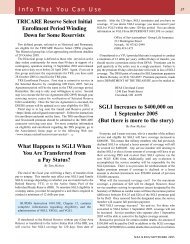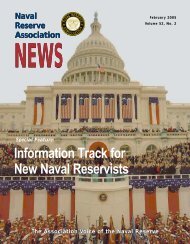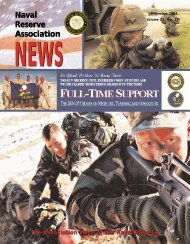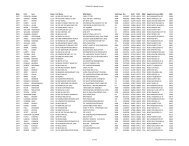Naval Reserve Association
Naval Reserve Association
Naval Reserve Association
- No tags were found...
Create successful ePaper yourself
Turn your PDF publications into a flip-book with our unique Google optimized e-Paper software.
Retirees’ CornerLCDR Joseph Golding, USNR (Ret)National VP for Retired PersonnelCaptain Derr is an officer of the Linewho has spent his civilian career inhealth care. In 2006, he finished a fouryeartour of work in Washington, DC,where he filled the position of ChiefOperating Officer of the American HealthCare <strong>Association</strong> which represents themajority of the long term facilities in theUS. He is very active in the LTC HealthInformation Technology initiative aswell as elderly care and pharmacy. He isa member of the VA CongressionalOversight Geriatric and GerontologyCommittee. Among numerous awards,he is a 2006 Purdue UniversityDistinguished Alumnus for his work inhealth care.Future Elderly Health CarePart 2This is article number two in aseries of three articles onelderly health. In the firstarticle, we discussed theindividual (you) and the waytechnology will change how welook at our own health and how we have to takeresponsibility for much of our own wellness.The technology change that will force achange is President Bush’s 2004 ExecutiveOrder to develop a national health careinfrastructure within ten years by having allhealth care providers interconnected andinteroperable, therefore, allowing the electronichealth record (EHR) and personal healthrecord (PHR) to become a reality.There are a number of barriers that willhave to be overcome as we move towards thisintegrated national health care system. Theimportant point is that this is not a technologyissue but financial and policy. Newt Gingrich,past House Speaker and founder of the Centerfor Health Transformation, when asked abouttechnology barriers to a national health caresystem, often uses the example of a personvisiting a foreign country and wanting cash.Today, you can walk up to a foreign ATM andinsert your hometown bankcard. In a matterof minutes you can have access to your bankaccount, know your account balance, haveU.S. currency converted to a local currencyand the money dispensed. Yet, if we wereliving at home, had a violent chest pain, andhad to go to a hospital emergency room, theywould not have access to your most recentvisit to the physician’s office or the testresults. Most likely, all the tests would have tobe redone, paperwork filled out on yourhistory, and time/money lost while thediagnostics were repeated. This is calledstatic health care.Since President Bush issued his ExecutiveOrder, much has been accomplished. Withinthe U.S. today, there are many cities, regions,and states that are taking the first stepstowards an integrated health care system.These sites have adopted the concept ofHealth Information Exchanges (HIE) orBy CAPT John F. Derr, USN (Ret)HEALTH INFORMATION TECHNOLOGYAND LONG TERM CARERegional Health Information Organizations(RHIO). Hospitals, clinics, and physicianoffices have decided to work together toexchange information within the rules HealthInsurance Portability and Accountability Actof 1996 (HIPAA) guidelines to protect yourpersonal information. They are taking thefirst steps in setting up the infrastructure byestablishing interconnectivity and interoperabilitybetween care settings. You can envisionthat once the county has regional connectivity,the next step will be a national infrastructure;and, then, we will be ready for the age ofelectronic and personal health records.The private sector has stepped up to theplate in acute and ambulatory care, and theinitiative is moving at a fast pace. Long termcare (LTC), which are mostly the elderly, isprimarily reimbursed by government programsand not by private insurance companies soadoption of HIT will take longer. Yet, LTCalready has a person-centric health informationsystem for skilled nursing facilities (SNF)and home care. SNFs have to access residentson a continuous basis with the Center forMedicare and Medicaid Services (CMS)mandated Minimum Data Set (MDS); andhome care, with Outcome and AssessmentInformation Set (OASIS). These arecomprehensive health information applicationsbut do not provide the complete quality-ofcareinformation for the resident.As the third priority HIT sector, the LTCsector is not waiting to be told what to dobut is working on interconnectivity andinteroperability within the elderly spectrumof care (home care, private care, day care,assisted living, skilled nursing home care, andhospice). Elderly care is unique in thatelderly persons usually have chronicconditions and move around the spectrumof care. As an example, going to the hospitalfor surgery, then to a nursing home forrehabilitation, then assisted living or home.This “bopping” (moving) around thespectrum of elderly care requires informationflow between care settings and an electronicand personal health record.24 NRA NEWS/APRIL 2007



